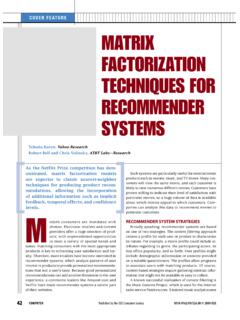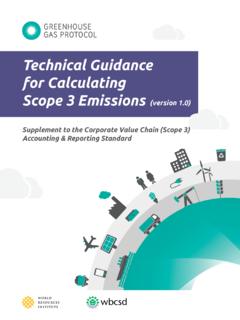Transcription of Supervised Machine Learning: A Review of Classification ...
1 Informatica 31 (2007) 249-268 249 Supervised Machine learning : A Review of Classification Techniques S. B. Kotsiantis Department of Computer Science and Technology University of Peloponnese, Greece End of Karaiskaki, 22100 , Tripolis GR. Tel: +30 2710 372164 Fax: +30 2710 372160 E-mail: Overview paper Keywords: classifiers, data mining techniques, intelligent data analysis, learning algorithms Received: July 16, 2007 Supervised Machine learning is the search for algorithms that reason from externally supplied instances to produce general hypotheses, which then make predictions about future instances.
2 In other words, the goal of Supervised learning is to build a concise model of the distribution of class labels in terms of predictor features. The resulting classifier is then used to assign class labels to the testing instances where the values of the predictor features are known, but the value of the class label is unknown. This paper describes various Supervised Machine learning Classification techniques. Of course, a single article cannot be a complete Review of all Supervised Machine learning Classification algorithms (also known induction Classification algorithms), yet we hope that the references cited will cover the major theoretical issues, guiding the researcher in interesting research directions and suggesting possible bias combinations that have yet to be explored.
3 Povzetek: Podan je pregled metod strojnega u enja. 1 Introduction There are several applications for Machine learning (ML), the most significant of which is data mining. People are often prone to making mistakes during analyses or, possibly, when trying to establish relationships between multiple features. This makes it difficult for them to find solutions to certain problems. Machine learning can often be successfully applied to these problems, improving the efficiency of systems and the designs of machines. Every instance in any dataset used by Machine learning algorithms is represented using the same set of features.
4 The features may be continuous, categorical or binary. If instances are given with known labels (the corresponding correct outputs) then the learning is called Supervised (see Table 1), in contrast to unsupervised learning , where instances are unlabeled. By applying these unsupervised (clustering) algorithms, researchers hope to discover unknown, but useful, classes of items (Jain et al., 1999). Another kind of Machine learning is reinforcement learning (Barto & Sutton, 1997). The training information provided to the learning system by the environment (external trainer) is in the form of a scalar reinforcement signal that constitutes a measure of how well the system operates.
5 The learner is not told which actions to take, but rather must discover which actions yield the best reward, by trying each action in turn. Numerous ML applications involve tasks that can be set up as Supervised . In the present paper, we have concentrated on the techniques necessary to do this. In particular, this work is concerned with Classification problems in which the output of instances admits only discrete, unordered values. Table 1. Instances with known labels (the corresponding correct outputs) We have limited our references to recent refereed journals, published books and conferences.
6 In addition, we have added some references regarding the original work that started the particular line of research under discussion. A brief Review of what ML includes can be found in (Dutton & Conroy, 1996). De Mantaras and Armengol (1998) also presented a historical survey of logic and instance based learning classifiers. The reader should be cautioned that a single article cannot be a 250 Informatica 31 (2007) 249 268 Kotsiantis comprehensive Review of all Classification learning algorithms. Instead, our goal has been to provide a representative sample of existing lines of research in each learning technique.
7 In each of our listed areas, there are many other papers that more comprehensively detail relevant work. Our next section covers wide-ranging issues of Supervised Machine learning such as data pre-processing and feature selection. Logical/Symbolic techniques are described in section 3, whereas perceptron-based techniques are analyzed in section 4. Statistical techniques for ML are covered in section 5. Section 6 deals with instance based learners, while Section 7 deals with the newest Supervised ML technique Support Vector Machines (SVMs).
8 In section 8, some general directions are given about classifier selection. Finally, the last section concludes this work. 2 General issues of Supervised learning algorithms Inductive Machine learning is the process of learning a set of rules from instances (examples in a training set), or more generally speaking, creating a classifier that can be used to generalize from new instances. The process of applying Supervised ML to a real-world problem is described in Figure 1. ProblemData pre-processingDefinition oftraining setAlgorithmselectionTrainingEvaluationw ith test setOK?ClassifierYesIdentificationof requireddataParameter tuningNo Figure 1.
9 The process of Supervised ML The first step is collecting the dataset. If a requisite expert is available, then s/he could suggest which fields (attributes, features) are the most informative. If not, then the simplest method is that of brute-force, which means measuring everything available in the hope that the right (informative, relevant) features can be isolated. However, a dataset collected by the brute-force method is not directly suitable for induction. It contains in most cases noise and missing feature values, and therefore requires significant pre-processing (Zhang et al.)
10 , 2002). The second step is the data preparation and data pre-processiong. Depending on the circumstances, researchers have a number of methods to choose from to handle missing data (Batista & Monard, 2003). Hodge & Austin (2004) have recently introduced a survey of contemporary techniques for outlier (noise) detection. These researchers have identified the techniques advantages and disadvantages. Instance selection is not only used to handle noise but to cope with the infeasibility of learning from very large datasets.







